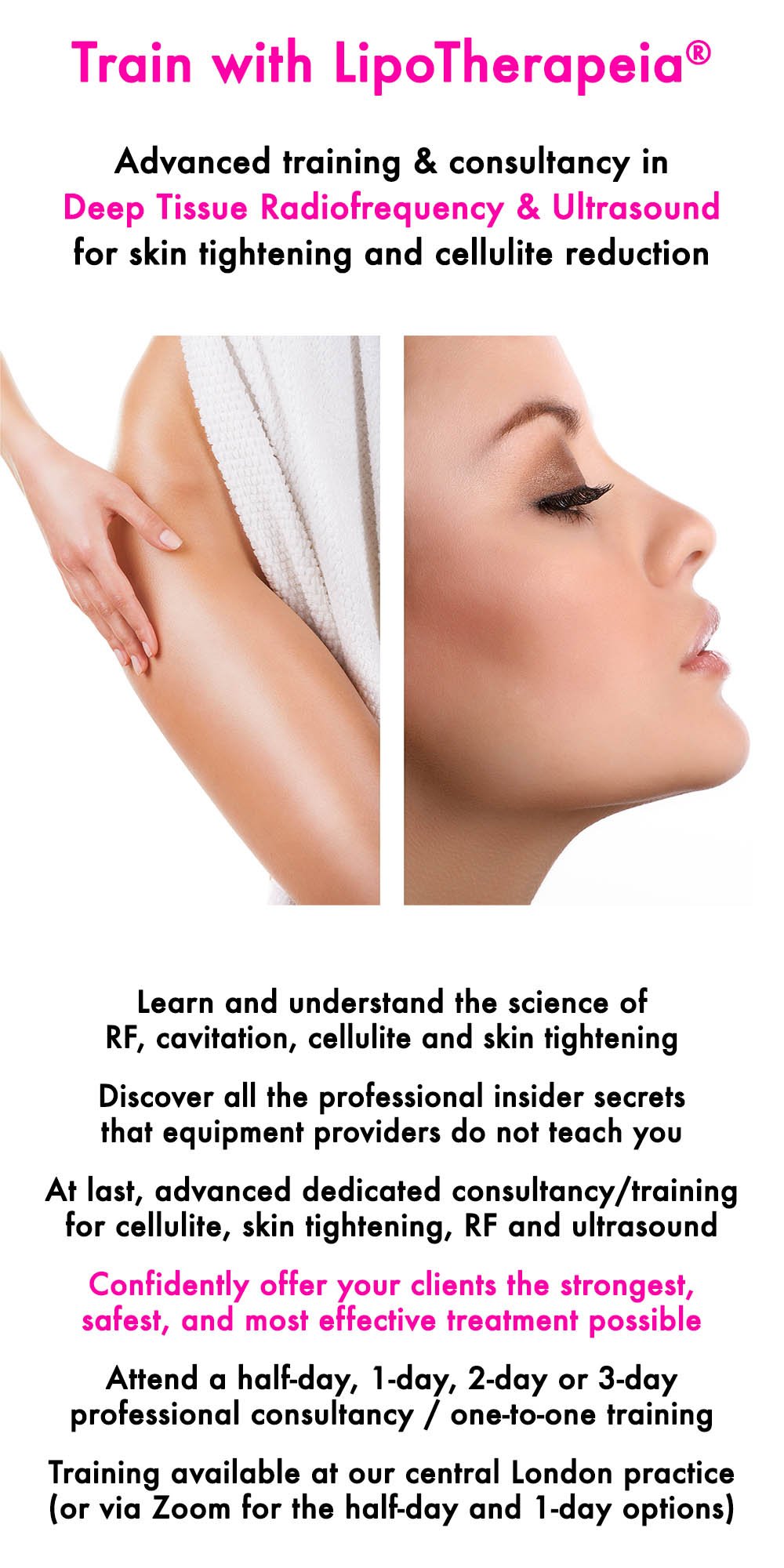Deep tissue RF for body skin tightening and cellulite removal
High-power, deep tissue radiofrequency: the ideal skin tightening and cellulite removal treatment
Where should deep tissue radiofrequency focus?
Superficial radiofrequency treatment is pointless
Too deep radiofrequency treatment is not a good idea either: don’t expect much fat reduction or skin tightening there
The ideal RF treatment should be what we call “deep tissue radiofrequency”, both safety-wise and effectiveness-wise
What makes a radiofrequency treatment “deep”?
High-power radiofrequency
High-power, deep tissue radiofrequency: the ideal skin tightening and cellulite removal treatment
We have made it repeatedly clear on this blog that when it comes to radio frequency treatment for cellulite and skin tightening, “deep is king”.
Specifically, we place emphasis on what we call deep tissue radiofrequency, meaning deep-acting, high-power radiofrequency.
Both “deep tissue” treatment AND “high power” treatment are important, because most radio frequency treatments are just:
Too superficial for the purposes of skin tightening and cellulite reduction, and therefore quite ineffective and/or inefficient
Too weak (i.e. of too low power) to increase and maintain temperature in the deep tissues for 15-40 minutes per area, which is required for good results
Where should deep tissue radiofrequency focus?
The aim of radiofrequency for cellulite removal and skin tightening should be to reach the dermis and especially the hypodermis.
Superficial radiofrequency treatment is pointless
For skin tightening and cellulite reduction, we do not want to go too superficial.
This is because with deep tissue RF, the epidermis is inadvertently treated indirectly in any case, but we do not want to focus on it. There are no collagen cells or collagen/elastin tissue in the epidermis - just keratin and keratinocytes - so no need to focus on the epidermis.
Plus, focusing on the epidermis will end up burning it before we properly affect the hypodermis.
Too deep radiofrequency treatment is not a good idea either: don’t expect much fat reduction or skin tightening there
However, we definitely do not want to go too deep either, i.e. we don’t want to go the subcutaneous tissue, for two reasons.
Regarding skin tightening there is little collagen type I and collagen type III in the subcutaneous adipose tissue (the retinaculae are very thin there), and the collagen type IV that is found around fat cells there just doesn’t respond very much. It’s difficult to tighten the subcutaneous tissue, and any such attempts do not provide much results.
Regarding subcutaneous fat reduction (also known as topical fat reduction), it practically seems that subcutaneous adipose tissue just does not respond very well to radiofrequency, ultrasound, HIFU, cryolipolysis, or lasers. In theory it does, but in practice the success rate is not more than 40-50% on the stomach/waist or 10-20% on the arms/thighs/butt, only with cryolipolysis (nothing else really works).
That’s the reality on the ground, as opposed to the BS in marketing brochures and hype on Instagram.
This is the reason we do not do fat reduction with RF, cavitation, cryolipolysis or lasers at the clinic: because 1 in 2 clients will not see results on the stomach and 8-9 out of 10 clients will not see results on arms/thighs/butt.
Of course, under no circumstances do we want to treat even deeper tissues, such as deep fascia and muscles, as this is both ineffective and beyond the scope of aesthetic treatments.
The ideal RF treatment should be what we call “deep tissue radiofrequency”, both safety-wise and effectiveness-wise
A well-trained therapist, who works on the dermis/hypodermis, can achieve maximum results with a typical 99.5% safety record or better (with the remaining 0.5% of treatments resulting to only minor, temporary adverse reactions).
So “deep tissue is king”, for both effectiveness AND safety, in regard to cellulite and skin tightening.
What makes a radiofrequency treatment “deep”?
Depth of penetration depends:
On equipment:
RF frequency
Monopolar / bipolar / unipolar electrode arrangement
Capacitive / resistive function
Suction / no suction
Cooling / no cooling of the radiofrequency tips
On treatment protocols used - there is no point having a Ferrari and not knowing how to drive it
And in many cases, on what products (gel, cream, oil or glycerol) are applied on the skin during treatment
As you can see from the comments on the different skin layers above, going too deep can be as pointless as going too superficial.
In an ideal world a knowledgeable therapist with the aid of some good equipment and an appropriate contact medium can specifically target the layers that they want, in order to achieve the best possible results for their customers.
Unfortunately, in 99% of the cases, RF training is as basic as it gets, so most therapists wouldn’t know where to start to treat specific tissues, even if they used good equipment.
And most machines are either not programmable for different tissue depths and/or they only act superficially.
In fact, most machines act on the epidermis, thereby negating the whole point of RF, which is supposed to provide deep heating.
Plus there are many myths and misconceptions, even propagated by machine manufacturers (who should know better), about what settings can create superficial or deep heating.
High-power radiofrequency
Of course, going “deep” is not enough, high power is also needed.
Again, just like most machines on the market are superficial, they are also of low power, with maximum power of as little as 60 Watts, which is inadequate even for face treatment.
You would be surprised by how many '“high-end” machines (corresponding to expensive treatment for you) offer a maximum of 60 Watts of power.
In contrast, a power of at least 250 Watts is required for an effective and efficient deep tissue body RF treatment, for both cellulite and skin tightening.
But that’s stuff to be analysed in another article…




![How to get rid of cellulite | 111 tips from the experts [2024 update]](https://images.squarespace-cdn.com/content/v1/5294cad9e4b009e918124a61/1582205124442-U31A5ECGNCG62VFPPJWJ/How+to+get+rid+of+cellulite+in+2020.jpg)


